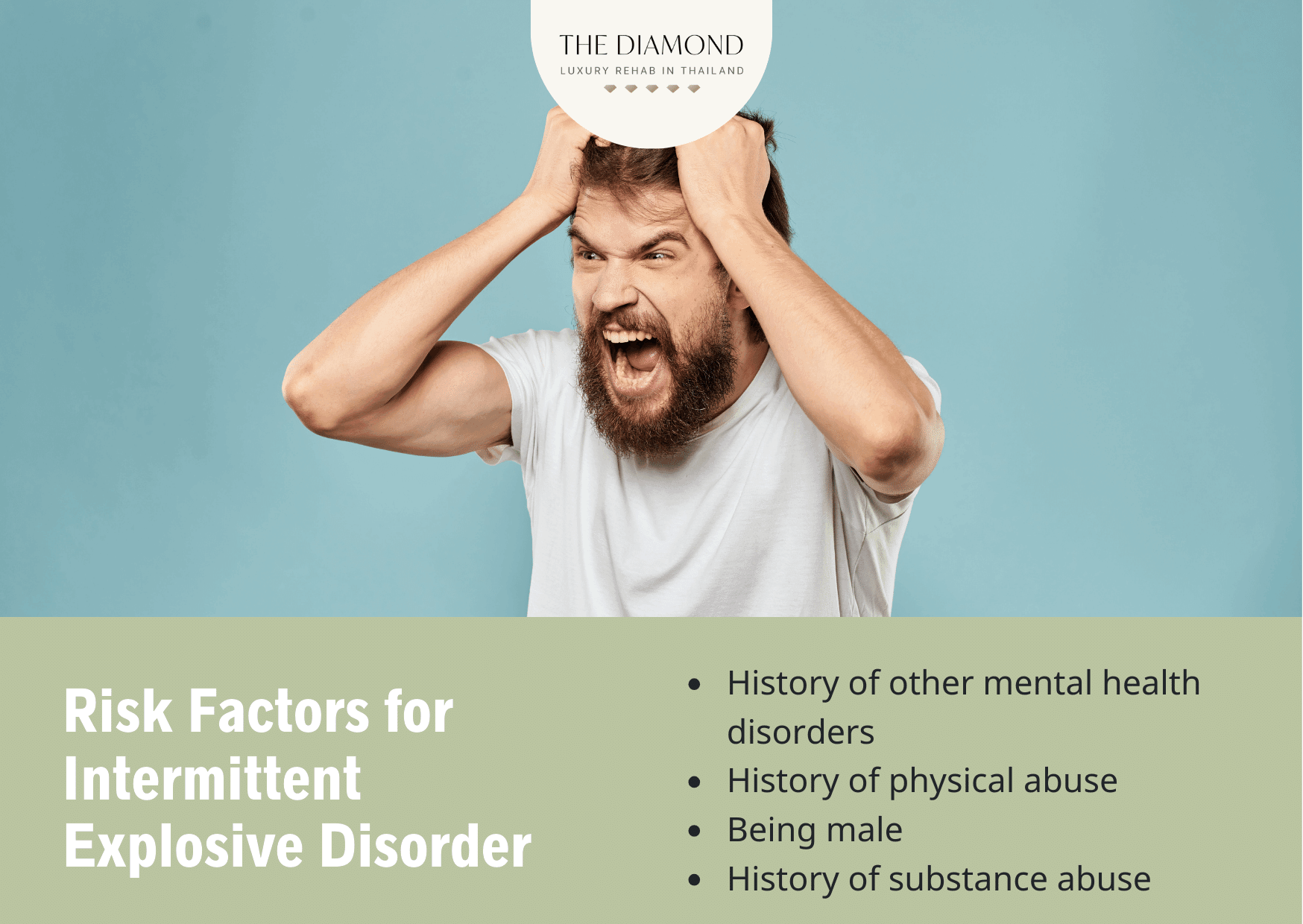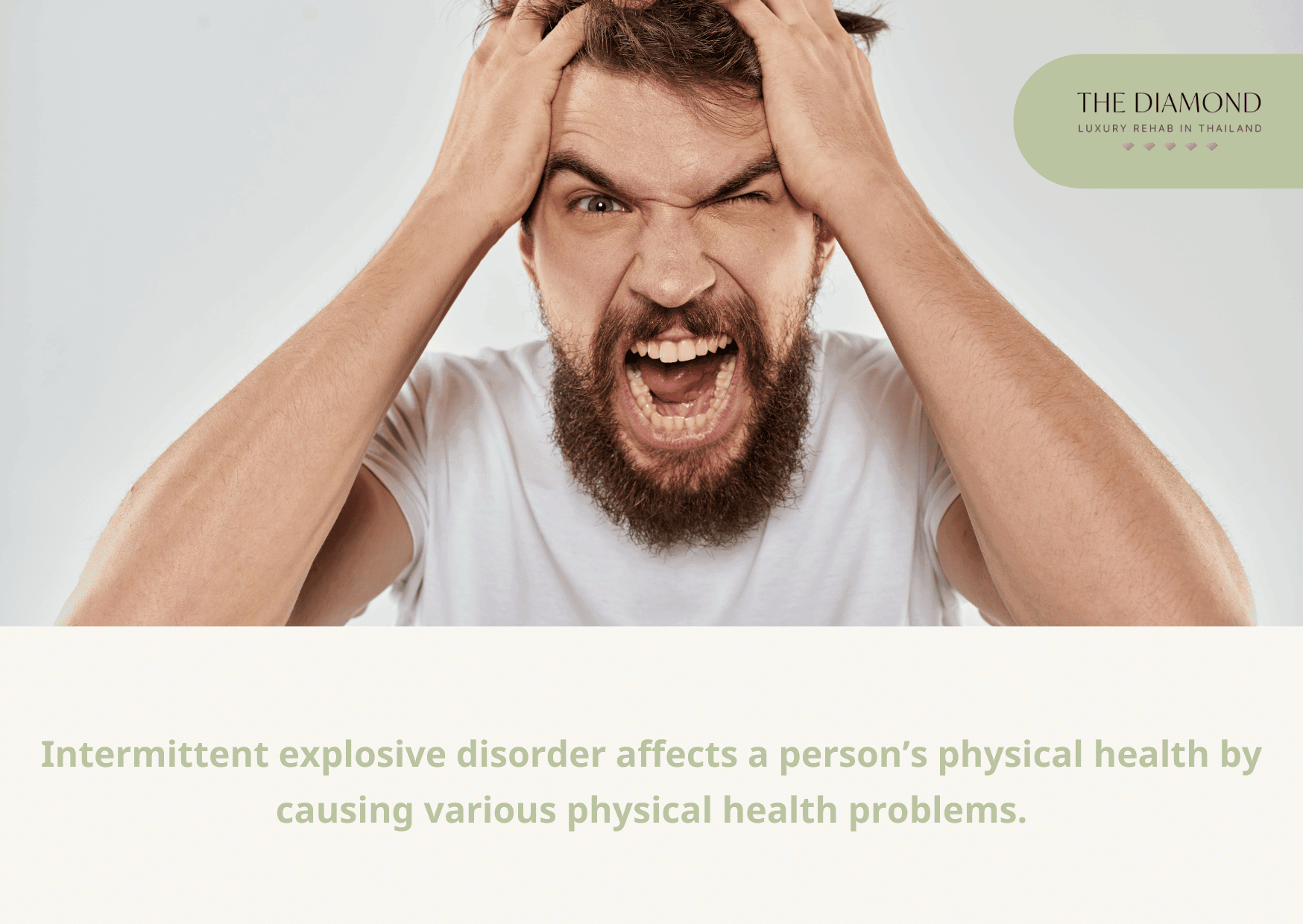Intermittent explosive disorder (IED): What to know about it?
Table of content
- What is Intermittent explosive disorder?
- What is the cause of Intermittent explosive disorder?
- What are the effects of Intermittent explosive disorder?
- What are the characteristics of Intermittent explosive disorder?
- What are the signs and symptoms of Intermittent explosive disorder?
- How to overcome Intermittent explosive disorder?
- What are the risk factors for Intermittent explosive disorder?
- What are the statistics on Intermittent explosive disorder?
- How do you treat Intermittent explosive disorder?
- What are the complications of Intermittent explosive disorder?
- How is an Intermittent explosive disorder diagnosed?
- Who is most likely to have Intermittent explosive disorder?
- What other conditions are possible to co-occur with Intermittent explosive disorder?
- How does Intermittent explosive disorder affect a person’s physical health?
- What is the relation between Intermittent explosive disorder and childhood trauma?

Intermittent explosive disorder (IED) refers to recurrent aggressive outbursts and violent behavior. It belongs to impulse control disorders.
The most common symptoms of IED include episodes of rage and aggression, damage to property, and even physical assault. The exact cause of IED is unclear, but studies show it has a genetic component. Environment and the presence of other mental health problems and substance abuse are common causes of IED disorder.
IED is characterized by recurrent impulsive and angry episodes that are not proportional to the situation. Angry outbursts aren’t mostly premeditated and are caused by impulses.
Treatment of the major impact on both the physical and mental health of IED to an individual is manageable with a combination of therapy and medication interventions.
Being male, young age, history of mental health disorders, and substance abuse are primarily affected by IED which are ri
What is Intermittent explosive disorder?
Intermittent explosive disorder is a type of impulse control disorder that is characterized by sudden outbursts of aggression, rage, and violence. The DSM 5 of the American Psychiatric Association further describes IED as frequent episodes of verbal or physical aggression that may or may not damage any properties and injure any individuals or animals involved due to failure to control aggressive impulses. It means that an individual with IED responds to certain triggers in an excessively aggressive manner, but their behavior isn’t planned. They react with fits of rage and aggression impulsively which is disproportionate to the situation.
Some examples of IED include domestic abuse, road rage, and temper tantrums. This disorder causes significant distress in a person’s life and affects the people around them. IED also harm physical health.
What is the cause of Intermittent explosive disorder?
The exact cause of the explosive anger disorder is ambiguous. A combination of different factors could play a role in its development. These include environment, genetics, and differences in how a person’s brain works.
This disorder may begin in childhood or adolescence. Growing up in households where a child is subjected to or witnesses explosive behaviors and physical or verbal abuse can contribute to the development of IED. According to a 2022 study published in the Pakistan Journal of Medical & Health Sciences by researcher Maryam Khan from SWPS University in Poland, parenting style is a crucial factor in a child’s development, and attitudes of indifference and harshness contribute to dysfunction among young adults.
Post-traumatic stress disorder (PTSD) may also contribute to the development of IED. A study published in the Journal of Anxiety Disorders by a team of psychologists from the VA Boston Healthcare System found that IED is prevalent among trauma-exposed male U.S. military veterans and is comorbid with PTSD. Due to the alterations caused by trauma in the brain function, people with PTSD may be more susceptible to emotional reactivity, impulsivity, and aggression.
Additionally, the explosive disorder has a genetic component, and it can also develop due to differences in the function, structure, and chemistry of the brain. Some people have abnormalities in the brain areas that regulate inhibition and arousal. Persons with IED also have differences in levels of the neurotransmitter serotonin, which is composed differently in this disorder.
What are the effects of Intermittent explosive disorder?
The effects of intermittent explosive disorder are listed below.
- Strained relationships with friends, family, coworkers
- Incarceration and legal problems
- Child or domestic abuse
- Suicidal thoughts and tendencies
- Self-harm
- Self-loathing and low self-esteem
- Substance abuse such as alcohol addiction and/or drug addiction
- Problems at work, school, and home
What are the characteristics of Intermittent explosive disorder?
Characteristics of intermittent explosive disorder revolve around failure to control aggressive impulses. The DSM 5 of the American Psychiatric Association describes the main characteristics associated with intermittent explosive disorder which are listed below.
- Verbal or physical aggression: toward people, animals, and property for three months. In this case, physical aggression doesn’t cause physical assault, damage, destruction of property, or injury to people and animals.
- Behavioral outbursts: three outbursts within 12 months that result in physical injuries to people and animals and damage to the property.
- Exaggeration: the magnitude of aggression is excessively out of proportion to the stressor that caused it.
- No premeditation: aggressive outbursts are recurrent but not premeditated; they are primarily anger- or impulse-based.
- No link to other mental health disorders or physical conditions: aggressive outbursts aren’t better explained by the presence of other mental health illnesses such as bipolar disorder, depression, and others. Also, it is impossible to attribute them to other medical conditions such as head trauma or Alzheimer’s disease.
Many mental health disorders and even some physical conditions can include episodes of aggressiveness. Intermittent explosive disorder has characteristics that are specific to patients with this condition. These characteristics also include:
- Verbal and physical aggression that may or may not cause physical injuries to people and animals and damage to the property.
- Intense aggressiveness even when the cause of the outburst isn’t that serious.
- Aggressive outbursts aren’t planned; a person doesn’t act this way to show dominance or intimidate someone and achieve a certain goal.
- Symptoms can’t be explained by other mental health problems.
- Aggressive outbursts cause significant distress in a person’s quality of life.
What are the signs and symptoms of Intermittent explosive disorder?
The signs and symptoms of intermittent explosive disorder manifest through aggressive episodes and explosive verbal and behavioral outbursts which are listed below.
- Rage and irritability
- Increased energy levels
- Road rage
- Chest tightness and heart palpitations
- Tremors and tingling
- Racing thoughts
- Tirades, rampages, and temper tantrums
- Yelling and shouting
- Heated and intense arguments
- Assaulting people or animals
- Threatening others
- Physical fights and altercations such as slapping, shoving, pushing
- Aggressive behaviors such as damaging property, breaking plates, and punching walls
- Domestic violence
- Headache or head pressure
In some cases, IED episodes occur frequently, but sometimes between weeks or months apart. A person with IED may have less severe verbal outbursts in between episodes of severe aggression. A study on emotion attribution in intermittent explosive disorder published in Comprehensive Psychiatry in 2021 emphasized that people with IED see and feel emotions differently than people without the disorder which is a significant factor in the manifestations of the disorder’s signs and symptoms. The symptoms of intermittent explosive disorder can be categorized into the following groups.
- Behavioral symptoms: temper tantrums, rampages, tirades, yelling and shouting, heated and intense arguments, physical assault, domestic violence, road rage.
- Physical symptoms: adrenaline rush, headache and/or head pressure, heart palpitations, chest tightness, muscle tension, tingling, tremors.
- Cognitive symptoms: racing thoughts, low frustration tolerance, lack of control over thoughts.
- Psychosocial symptoms: rage, irritability, emotional detachment.
How to overcome Intermittent explosive disorder?
To overcome intermittent explosive disorder, a proactive approach is necessary which requires seeking professional help. The helpful ways to overcome explosive mood disorder are listed below.
- Avoiding recreational drugs and alcohol
- Trying relaxation techniques such as deep breathing, meditation, yoga
- Stepping away from triggers or responding to them in a healthier manner
- Getting enough sleep
- Regular exercise
- Stress management
- Creating a plan of action with a therapist for triggering situations
Besides the doctor-recommended treatment, patients with IEDs may implement adjustments in daily life that will help with overcoming the disorder. These adjustments that help overcome IED include:
- Relaxation techniques and practices
- Healthy lifestyle measures
- Improving reaction to triggers of aggressiveness
- Improving communication skills
- Learning to process and channel negative moods and emotions such as anger without harming oneself and others
What are the risk factors for Intermittent explosive disorder?
The risk factors for intermittent explosive disorder are listed below.
- History of other mental health disorders
- History of physical abuse
- Being male
- History of substance abuse
- Having experienced emotional trauma
- Exposure to explosive behaviors in childhood
According to a study on the cross-national epidemiology of DSM-IV intermittent explosive disorder published in Psychological Medicine, the lifetime prevalence of IED in different countries ranged from 0.1 to 2.7%, and the most significant risk factors for this disorder include:
- Gender (male)
- Young age
- Being socially disadvantaged
- Early exposure to violence, especially during childhood
- Experiencing coexisting disorders, such as alcohol abuse and depression
What are the statistics on Intermittent explosive disorder?
The statistics of intermittent explosive disorder reveal that around 7.3% of adults in the United States are affected. According to the National Institutes of Health, depending on how broadly the condition is defined, up to 7.3% or 11.5 to 16 million adults in the U.S. suffer from intermittent explosive disorder.
Additionally, according to a study on the cross-national epidemiology of DSM-IV intermittent explosive disorder published in Psychological Medicine, the lifetime prevalence of IED in the general adult population is 1% to 4%, while the 12-month prevalence ranges from 1% to 3%.
A study on the intermittent explosive disorder subtypes in the general population published in the Epidemiology and Psychiatric Sciences found that the lifetime prevalence of intermittent explosive disorder in all countries was 0.8%. Of these, 73% of people experienced anger attacks that damaged property and harmed other individuals.

How do you treat Intermittent explosive disorder?
Treatment of intermittent explosive disorder involves a combination of therapy and medications.
The main objective of therapies is to help patients adopt coping mechanisms that will allow them to react to negative stimuli in a healthy manner. It also involves learning how to deal with the disorder and identify negative thoughts and patterns to replace them with positive ones.
The most effective therapy for IED is cognitive-behavioral therapy (CBT). This type of behavioral therapy works by helping patients identify the situations and behaviors that trigger fits of anger or aggressive responses. At the same time, patients learn to manage anger and control inadequate responses through relaxation techniques, cognitive restructuring, and improving problem-solving and communication skills. CBT helps people with IED develop skills to manage impulse aggression in response to non-provocative stimuli.
A study published in the Journal of Consulting and Clinical Psychology by various professors and psychiatrists from different institutions in Colorado and Illinois confirmed the benefits of CBT in the treatment of intermittent explosive disorder. The positive effects of cognitive-behavioral therapy were maintained at the three-month follow-up as well. Moreover, a study on cognitive-behavioral group therapy for intermittent explosive disorder published in the Brazilian Journal of Psychiatry found that CBT led to a significant reduction in all anger scales in persons with intermittent explosive disorder.
Psychotherapy sessions in intermittent explosive disorder treatment are performed in an individual or group setting. Anger management programs and support groups are beneficial for the treatment of IEDs. Patients get to share experiences with the disorder and support others while also receiving help and support in return.
Patient education is a significant component of the treatment of this disorder. Healthcare professionals strive to educate patients on what is IED disorder to understand it better and acknowledge problematic behaviors that can be managed adequately.
While there is no specific intermittent explosive disorder medication, healthcare professionals may prescribe drugs to treat underlying mental health problems. These medications usually include antidepressants.
Some patients also try alternative therapies such as acupuncture and acupressure. It is important to note that alternative therapies aren’t a replacement for the IED medical approach or doctor-recommended treatment.
What are the complications of Intermittent explosive disorder?
Complications of intermittent explosive disorders are significantly associated with psychosocial impairment and disability that affect both interpersonal and intrapersonal relationships. According to a 2019 study on psychosocial impairment in DSM-5 intermittent explosive disorder published in Psychiatry Research, individuals with IED tend to experience higher levels of psychological distress, endure lower levels of overall life satisfaction, and bear greater difficulties in maintaining stable employment and healthy relationships. Mayo Clinic also reports that intermittent explosive disorder can cause or aggravate mood disorders such as depression and anxiety.
How is an Intermittent explosive disorder diagnosed?
Intermittent explosive disorder is diagnosed based on the criteria established in the DSM 5 of the American Psychiatric Association. The same study published in Psychiatry Research further explains that the diagnoses involve structured clinical interviews that tackle different mental health problems and disorders. In addition to those interviews is a clinical interview conducted by a research psychiatrist to ask in detail about the associated symptoms and history of the disorder. Clinical evaluation of the medical records, test results, or reports from family members may also be necessary to support existing information. All these sources of information are essential to make a reliable and valid diagnosis that aligns with the DSM 5 criteria.
Who is most likely to have Intermittent explosive disorder?
Men are more likely to develop intermittent explosive disorder. The average age of onset of IED is 17 years, but it ranges from 13 to 23 years in different countries. Individuals who grew up in an unstable home are more likely to have an IED. For example, some people were exposed to aggressive behavior and verbal or physical abuse in childhood.
Unemployed individuals have higher odds of developing IED as well as individuals who experienced divorce or marital separation. Moreover, individuals with other mental health problems and persons with substance use disorders are also at risk of developing IED.
What other conditions are possible to co-occur with Intermittent explosive disorder?
Other conditions that tend to co-occur with intermittent explosive disorder are listed below.
- Attention deficit hyperactivity disorder (ADHD)
- Anxiety
- Antisocial personality disorder
- Borderline personality disorder
- Substance abuse disorder
- Conduct disorder
- Oppositional defiant disorder (ODD)
- Bipolar disorder
- Depression
- Post-traumatic stress disorder (PTSD)
This anger disorder can contribute to or worsen many other conditions. The most common co-morbidities include:
- Anxiety disorders
- Mood disorders
- Behavioral and personality disorders

How does Intermittent explosive disorder affect a person’s physical health?
Intermittent explosive disorder affects a person’s physical health by causing various physical health problems. Individuals suffering from intermittent explosive disorder are highly exposed to risks of coronary heart disease, stroke, hypertension, diabetes, back and/or neck pain, arthritis, ulcers, chronic pain, and headaches. A study published in Healthy Psychology by a team of professors from various institutions across the U.S. further adds that intermittent explosive disorder is a risk factor for serious physical health outcomes.
What is the relation between Intermittent explosive disorder and childhood trauma?
The relationship between intermittent explosive disorder and childhood trauma is that the latter is a major risk factor for developing recurrent aggressive outbursts in adulthood. A study on the relationship between childhood exposure to trauma and intermittent explosive disorder published in Psychiatry Research confirms that childhood trauma is strongly associated with anger disorders.
The first signs of intermittent explosive disorder may occur in childhood, which correlates with reactions to trauma due to exposure to aggressive behaviors or being subjected to physical or verbal abuse.
Children learn and develop interpersonal relationships and how to process and manage their emotions properly. Trauma in childhood disrupts this process. Consequently, affected children struggle with managing their emotions or responding to negative stimuli in a healthy manner. They may also lack the communication skills necessary for interpersonal relationships.

